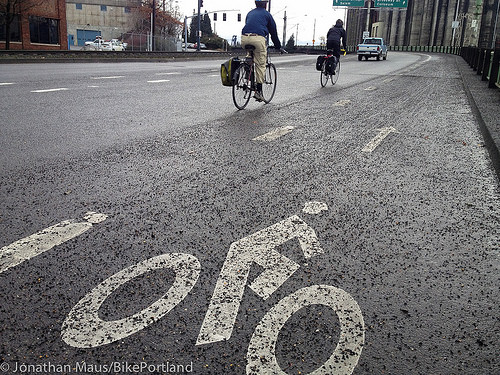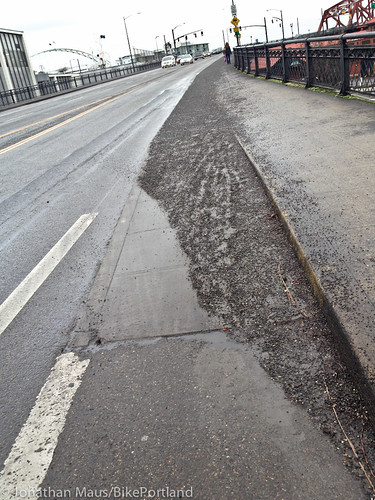It’s been a challenging week transportation-wise here in Portland. First we were hit by snow and strong winds, then freezing rain, then a blanket of ice. After that, we had to trudge through tricky slush-piles. Now, thankfully, the weather is getting back to normal; but one last challenge remains: gravel.
“It’s like pouring rice over your floor. If you sweep it up, you’re still going to find kernels later.”
— Diane Dulken, PBOT
All three of the transportation agencies in the Portland area — the Portland Bureau of Transportation (PBOT), the Oregon Department of Transportation (ODOT) and Multnomah County — use sand or gravel to improve traction when snow and ice are on the roads (we don’t use salt around these parts due to its environmental impacts). That means when the snow and ice melts, the gravel remains. And since auto and truck tires automatically sweep the tiny little rocks out of standard vehicle lanes, it all ends up in the shoulders, bike lanes, sidewalks and paths that people on bikes rely on.
We contacted all three agencies to find out more about how much gravel they laid down, and more importantly, how and when they plan to pick it all up.
Diane Dulken on PBOT’s communications team said it “will be a several week process” before they can pick up the 1,000 cubic yards (about as much as 1,000 pick-up trucks full) of gravel they laid down. “It’s like pouring rice over your floor. If you sweep it up, you’re still going to find kernels later,” she said on the phone today.
The last time Portland got this much snow was back in the big storm of 2008. Dulken said it took their crews 6-8 weeks to pick up all the gravel after that storm; but this time around PBOT hopes to shorten that timeframe. City sweeper crews will work in pairs and Dulken said it will take more than one pass to get it all. And yes, they do plan to recycle it once it’s all picked up.
Dulken said crews started the process yesterday by making their first passes along the N Williams/Vancouver couplet. Today they’re remaining in north Portland with daytime crews focused on N Lombard, Willamette, and Rosa Parks Way. Night crews will tackle the Central Business District and bridge approaches* first, a.k.a., “The places that have the most impact on people biking, walking, taking transit, and driving,” said Dulken.
(*PBOT is responsible for just the approaches to bridges while Multnomah County is responsible for bridge decks and paths.)
In addition to sweepers, this year PBOT is experimenting with crews that will try to flush the gravel into the gutter and off of sidewalks with water hoses. PBOT doesn’t apply gravel directly onto the sidewalks, but it ends up there after plowed snow melts away.
As we roll through these next couple of weeks, Dulken said everyone should be advised and go slower, especially on downhills. (To report an especially bad spot, call (503) 823-1700.)
Multnomah County’s road maintenance department is much smaller than PBOT or ODOT; but they still have a gravel pick-up plan. Spokesman Mike Pullen said today that the biggest hot spot on their list right now is the Burnside Bridge, which, unlike other downtown bridges, has a curbside bike lane that’s not separated from the standard vehicle lanes. Pullen added that County maintenance crews have already swept several sections of Skyline Blvd but they haven’t started to clean bridges yet.
“We’re very aware of the issues this sand has for bicyclists.”
— Don Hamilton, ODOT Region 1
“First, our crews have to get rested up,” is what ODOT Public Information Officer Don Hamilton told us when we asked about gravel pick-up today. With many more lane miles to take care of than PBOT, ODOT’s Region 1 maintenance teams are worn out from the past week. Hamilton said they laid down 8,000 cubic yards of gravel since Thursday — that’s eight times as much as PBOT.
Before they can start picking up all that gravel, Hamilton said, crews will go out and clean up general storm debris. “Things like car chains, truck chains, and car parts,” Hamilton said, referring to the array of detritus a storm leaves behind. Similar to PBOT, Hamilton made it clear that the gravel won’t be gone anytime soon. “Sweeping is not a quick process,” he said, “It takes many, many times over to get it right.” They’ll do most of their work at night and Hamilton said we can expect the gravel to be mostly gone in 1-2 weeks.
With such a broad management area, Hamilton said each local maintenance crew makes their own decisions about where to send sweepers. The public can help direct their attention to hotspots by reporting them to the district maintenance office at (971) 673-6200.
Hamilton also added that sweepers will focus on getting the gravel out of shoulders and bike lanes. “We’re very aware of the issues this sand has for bicyclists,” he said, “We’re trying to make things clean for them.”
— Read all our 2014 Winter Storm coverage here.



